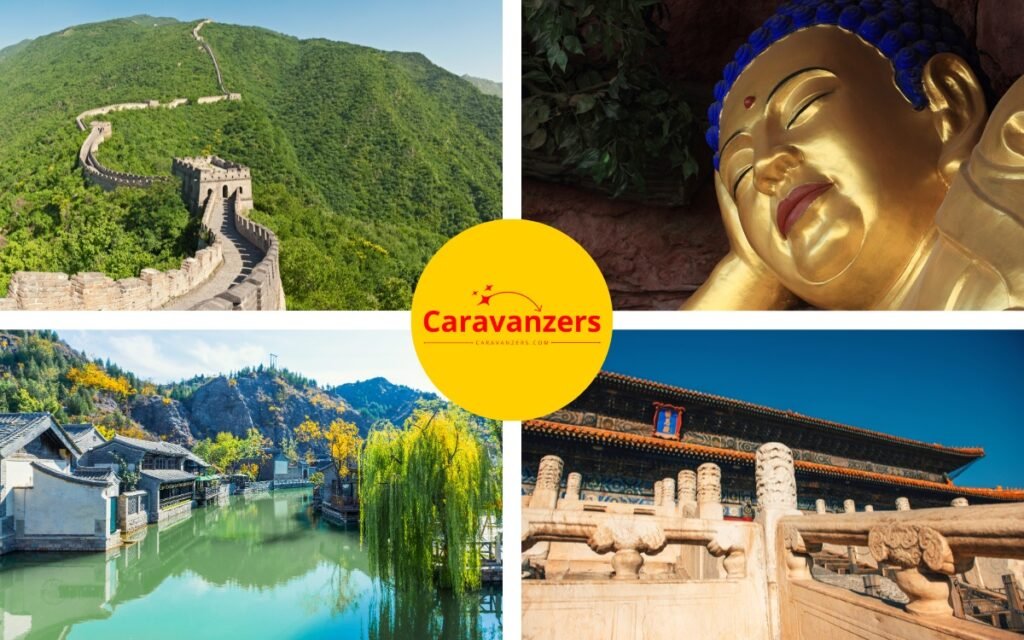
Great Wall of China. This travel guide will show you why millions of tourists flock to this ancient structure every single year.
So, basically, the Great Wall of China was never supposed to be a tourist attraction. Instead, it was built during several dynasties… to protect the empire from invasions.
The wall features watchtowers, fortresses, and defensive structures that embody the architectural brilliance of ancient China.
In this guide, I will describe basic facts, as well as how to visit from Beijing.
Meanwhile, I will make sure to include important items like what to see there, what nearby destinations to consider, and so much more.
So, let’s start our adventure to the Great Wall of China!
Great Wall of China Facts

In Mandarin, the Great Wall of China is “长城” or Chángchéng, which translates to “City Wall.”
When the construction started, it was indeed a city wall.
A symbol of the country’s grandeur, the Great of China holds remarkable historical and cultural significance.
Some key points about the Great Wall that will deepen your understanding of this remarkable wonder.
First of all, it stretches over a staggering length of about 13,171 miles or 21,196 kilometers.
Without a doubt, that makes it the longest human-made design in our world.
The earliest construction dates back to the 7th century BC, and that means it’s probably also one of the longest construction in history since it was built and expanded over centuries.
Different Chinese dynasties, such as the Qin, Han, and Ming, as well as the Qing, contributed to its construction and renovation, and the purpose was clearly a defensive barrier.
It acted as a fortified line of defense, allowing the Chinese empires to safeguard their territories and maintain control over trade routes.
Beyond its military function, the Great Wall also had economic, cultural, and symbolic importance, reflecting the grandeur and power of the Chinese civilization.
Since 1987, the Great Wall of China has been a UNESCO World Heritage Site.
Naturally, this has hugely contributed to its immense popularity as a tourist destination.
Visit from Beijing

With its rich history, cultural attractions, and convenient transportation options, Beijing is a seamless transition to exploring this ancient marvel.
Travelers can take advantage of public buses or the Beijing Subway to reach various sections of the Great Wall.
Bus services operate from major bus terminals, while certain subway lines have direct connections to specific sections like Badaling and Mutianyu.
Many tour agencies in Beijing offer guided tours to the Great Wall, providing transportation and a knowledgeable guide to enhance the experience.
These tours often include convenient hotel pick-up and drop-off.
To fully appreciate the Great Wall from Beijing, it is advisable to allocate a minimum of one full day.
This allows sufficient time to explore a specific section, take in the breathtaking views, and immerse oneself in the history and magnificence of the wall.
However, for more in-depth exploration, extending the visit to two or more days would provide an enriched experience.
The weather is generally pleasant in the spring and fall, with mild temperatures and less rainfall.
These periods also offer stunning natural scenery, such as blooming flowers in spring and vibrant foliage in autumn.
Some establishments offer stunning views of the wall from their rooms.
For a more immersive experience, travelers can opt for guesthouses or homestays in nearby villages.
These provide an opportunity to engage with local communities, experience authentic Chinese hospitality, and savor traditional cuisine.
Selecting the most convenient transportation mode, allocating sufficient time, and choosing suitable accommodation options near the Great Wall will contribute to a memorable and fulfilling visit from Beijing.
Etiquette at the Great Wall
It’s really important to follow certain etiquette to show respect for the site and its cultural significance.
So, here are my top ones to keep in mind.
Wear comfortable clothing and suitable footwear for walking and climbing.
Consider the weather conditions and dress modestly, as the Great Wall is a place of historical and cultural importance.
Follow the instructions and guidelines provided by the authorities, such as staying on designated paths, not littering, and not defacing or damaging the wall or its surroundings.
The Great Wall can get crowded, especially at popular sections.
Be considerate of others by not pushing or shoving and allowing people to pass if needed.
Maintain a reasonable distance from other visitors to avoid overcrowding.
The Great Wall is a place of tranquility and reflection.
Keep your voice down and avoid unnecessary noise, such as loud conversations, shouting, or playing loud music.
Respect the peaceful atmosphere for everyone’s enjoyment.
Help protect the environment by not leaving any litter behind.
Leave the Great Wall as you found it, so others can appreciate its beauty.
The Great Wall is an ancient structure with historical significance.
Do not touch or remove any stones, bricks, or artifacts from the wall.
Leave everything in its place to ensure its preservation.
Be polite and considerate towards the local people, and follow any cultural norms you encounter.
Some sections of the Great Wall can be steep and challenging to climb.
Be cautious, especially if you have physical limitations or are traveling with children.
Wear appropriate footwear and take necessary precautions to ensure your safety.
So, yeah, you can have a respectful and enjoyable visit to the Great Wall of China while preserving its historical and cultural significance for future generations.
What to See at the Great Wall

So, over the years, I met travelers who are often surprised to hear that the Great Wall of China consists of multiple sections.
More importantly, each of these sections has its own characteristics and significance.
Understanding these sections will help visitors choose the most suitable one for their exploration.
Known for its accessibility and well-preserved condition, Badaling is one of the most visited sections.
It offers a magnificent panoramic view and showcases the iconic features of the Great Wall.
Renowned for its picturesque surroundings, Mutianyu combines natural beauty with ancient architecture.
It features a variety of guard towers and offers activities such as cable car rides and toboggan descents.
Jinshanling presents a more rugged and less crowded experience, and it’s very popular because of the diverse architectural styles and unbelievable views of the surrounding landscape.
Each section of the Great Wall exhibits unique features, such as architectural styles, wall conditions, and natural surroundings.
Visitors can encounter various types of watchtowers, beacon towers, and defensive structures, showcasing the engineering ingenuity of different dynasties.
Apart from the awe-inspiring wall itself, visitors can explore additional attractions along the Great Wall.
These include historic temples, fortresses, and cultural landmarks.
Notable highlights include the Temple of Heaven, the Ming Tombs, and the Summer Palace.
Now, make sure to wear appropriate footwear and clothing, as some sections can be steep and uneven.
Carry water and snacks, especially during longer hikes, and be cautious while walking on the wall, particularly in areas with loose stones or steep steps.
Respect cultural heritage by refraining from vandalism or littering, following designated paths and avoiding venturing into restricted or dangerous areas.
Be mindful of weather conditions and check for any advisories or closures before visiting.
That’s it!
Places Near the Great Wall of China to Visit

The vicinity of the Great Wall of China offers a multitude of captivating destinations worth exploring.
These nearby cities and attractions provide a perfect complement to the Great Wall experience, showcasing the diverse cultural and historical heritage of the region.
As the starting point for most Great Wall visits, Beijing itself is a treasure trove of cultural landmarks.
Discover the Forbidden City, Tiananmen Square, and the Temple of Heaven, among other renowned sites.
Chengde, in the nearby Hebei Province, is famous for its imperial summer resort, the Chengde Mountain Resort.
This UNESCO World Heritage Site boasts stunning palace complexes, beautiful gardens, and serene lakes.
It’s a great place to eat some delicious food.
Situated in Changping District, Beijing, the Ming Tombs house the mausoleums of several Ming Dynasty emperors.
Explore these grand burial sites, including the impressive Dingling Tomb, and learn about imperial rituals and architectural styles.
Located near the Simatai section of the Great Wall, Gubei Water Town offers a charming blend of traditional Chinese architecture and a network of canals.
Immerse yourself in Confucian philosophy and Chinese cultural heritage at this ancient temple.
Experience the tranquil atmosphere, admire the intricate architecture, and learn about the teachings of Confucius.
Venture further north to Datong, where you can visit the awe-inspiring Yungang Grottoes.
These remarkable caves house over 51,000 Buddhist statues and are a testament to the artistic and religious legacy of ancient China.
Exploring the nearby cities, attractions, and cultural sites allows visitors to delve deeper into the rich history and cultural tapestry of China, enriching their Great Wall journey with even more memorable experiences.
Great Wall of China Itinerary

On the first day, depart from Beijing and reach your chosen section of the Great Wall.
Spend the day hiking and exploring, taking in the stunning vistas that unfold before you.
Enjoy an overnight stay at a hotel near the Great Wall, ensuring a peaceful and convenient experience.
On the second day, venture out to other sections of the Great Wall, each with its own unique features.
Engage in activities like cable car rides or toboggan descents to add excitement to your journey.
Take time to explore cultural landmarks or nearby towns, immersing yourself further in the history and charm of the region.
On the third day, broaden your exploration by venturing into the surrounding areas.
Visit attractions such as the Ming Tombs or Chengde Mountain Resort, where you can delve deeper into the local culture and cuisine.
Maybe catch a local wedding!
In the evening, return to Beijing, reflecting on the incredible experiences you’ve had throughout your journey.
During your visit, take breaks during your hike to rest, hydrate, and capture memorable photos.
Engage in cultural activities like calligraphy or tea ceremonies, allowing yourself to immerse yourself in the traditions of China.
And don’t forget to witness the breathtaking sunset over the Great Wall, a moment that will stay etched in your memory.
To optimize your itinerary, customize it based on your fitness level, preferred sections of the Great Wall, and the amount of time you have available.
Prioritize the sections that intrigue you the most, whether it’s due to their historical significance or natural beauty.
Allocate ample time for transportation and unexpected delays to avoid rushing.
Consider hiring a knowledgeable guide who can provide deeper insights into the history and culture of the Great Wall, enhancing your overall experience.
Final Thoughts
So, throughout our journey in this guide, I trust you experienced the full splendor of the Great Wall.
The incredible dedication, hard work, and sacrifices that went into building this monumental feat of human achievement are truly remarkable.
I hope you will able to envision the countless soldiers and laborers who toiled tirelessly, placing each brick with precision to create a formidable defense against invaders.
This was why it was important to me to place an etiquette section because it’s your responsibility and mine to support its future.
So, I hope you get to take a ton of selfies and videos to share with friends and family back home!
Enjoy your trip.
Li Xiu Ying is a travel writer and is the author of Beijing Travel. She writes about China for Caravanzers.
Follow us on Pinterest.
